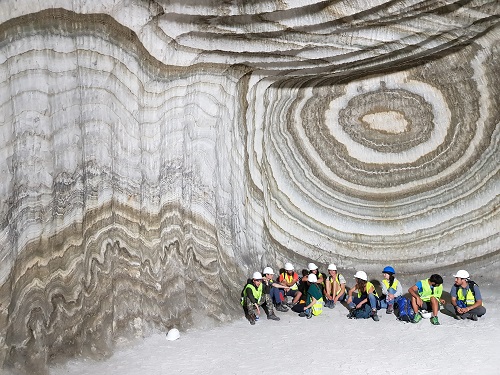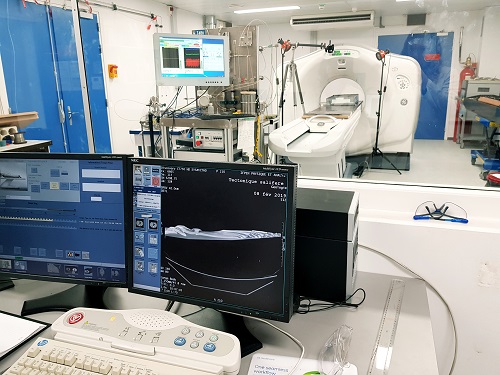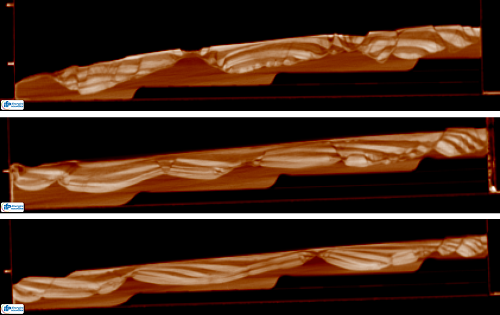Evans, S., Subterranean Salt Structures and Sandbox Science. Geoscientist 30 (5), 10-13, 2020
https://doi.org.doi: 10.1144/geosci2020-086, Download the pdf here
Sian Evans on how a CT scanner is helping to understand subterranean salt giants
It was a drizzly, grey morning when I arrived in the suburbs of Paris, sluggish from catching the first Eurostar at the crack of dawn but excited for the challenge ahead. I navigated my way through the windy streets in search of IFP Energies Nouvelles (IFPEN) - a renowned research organisation specialising in applied geoscience for the energy industry, which houses a dedicated lab for physical analogue modelling.
A myriad of models
During the previous year I had designed several models to test some of the ideas I was developing as part of my PhD at Imperial College in London. Thanks to generous grants awarded to me by the Geological Society and AAPG, I was given the opportunity to run some of these models within the specialist lab at IFPEN.
In the 21st century, an era of data abundance and ever-increasing computational power, models - simplified descriptions of a system or process, to assist calculations and predictions - have a myriad of applications. We have models predicting everything, from the weather, the traffic and the growth of the economy, to which posts you’re most likely to engage with on social media and how you’re going to vote in the next election. Models seem to be taking over. But my models are not trying to predict the future - they’re trying to see into the past.

Salt giants
Left: deformed Messinian evaporites in the Realmonte salt mine, Sicily
Let’s take a step back. My PhD is in the field of salt tectonics. One of the unique properties of salt is that it flows like a fluid over geological timescales, creating extremely complex deformation patters. Thick salt deposits are buried in many sedimentary basins around the world and my research investigates the significant impact such deposits have on the structural development of those basins.
These subterranean salt giants can be absolutely enormous -take the Mediterranean, for example. At present the Med is connected to the open waters of the Atlantic via a narrow passage through the Gibraltar Straits, but around 6 million years ago this connection was disrupted. The Med became an isolated body of water, and intense evaporation caused water levels to drop. As more and more water was evaporated the salinity of the remaining seawater increased, until salt started to precipitate and settle on the seafloor. This dramatic event is known as the Messinian Salinity Crisis, and it led to the deposition of the world’s youngest salt giant – a thick unit of salt deposited across the Mediterranean basin.
Today, these salt giants are not only under water but also buried beneath several kilometres of sand, which means we need to use geophysical techniques to study them. The most common of these utilises seismic data; sound waves which travel through the subsurface, reflect off internal boundaries within the rock and are received back at the surface. These waves are then used to create an image of the subsurface. Using this method, we can see underground faults, folds and other structures that would otherwise be invisible to us.
Sandbox science
 Right: Analogue modelling in action: applying additional sand layers at certain time intervals during model runs (left), and ensuring even distribution of sand layers (right)
Right: Analogue modelling in action: applying additional sand layers at certain time intervals during model runs (left), and ensuring even distribution of sand layers (right)
Seismic data is a powerful tool for subsurface exploration, but it only reveals what the deformed rock looks like at the present day. How did these structures form? Which factors controlled their development? That’s where the modelling comes in. Modelling is particularly useful in this case as we are dealing with processes that take place over millions of years and thousands of kilometres. In order to observe these in action on human scales, we have to condense that down to a matter of hours and centimetres. We do this by creating a scaled down replica of the system – a physical analogue model.
First, we have to scale down the physical properties we’re working with, such as the viscosity of the salt, the cohesive strength of the overlying rock and the sedimentation rate. All these parameters must be scaled down proportionally, otherwise our model will not physically represent the natural system. We use silicone to represent the salt layer; a liquid viscous enough for you to hold in your hand but which will slowly seep through your fingers. Loose sand layers represent the overburden rock, with syn-kinematic sedimentary layers added as the model progresses. Physical analogue models are therefore informally known as sandboxes, but it’s not quite as playful as it sounds!
One rather unique advantage of the IFPEN lab is that they possess a CT scanner in which they can run the models. This is exactly the same type of medical scanner used in hospitals to acquire brain scans and body scans. In fact, it was bought second hand from a hospital. The scanner enables us to see what is happening inside the model as it runs - otherwise, we would only be able to monitor the deformation of the surface or sides as it deforms, and would have to cut up the model at the end to look inside. This way, there is no need to slice it open, and we can image it internally in real time to acquire a full 4D evolution of the model.
Surface geometry
 Left: The lab setup at IFP Energies Nouvelles: Models run within a CT scanner and
Left: The lab setup at IFP Energies Nouvelles: Models run within a CT scanner and
imaged in real time as they deform, revealing their internal structural complexity
The models I ran at IFPEN were specifically designed to test the influence of salt flow over steps on the base-salt surface. Since salt behaves as a fluid, it is sensitive to the geometry of the surface that it flows across; for example, pre-existing fault scarps at the base of the salt deposit. The models allowed the silicone to flow over a series of steps and ramps at different angles. Each of these models was run for different starting conditions in order to isolate the effect of different variables and their relative importance. As it turns out, relief on the base-salt has a profound impact on the subsequent structural evolution of the salt and overlying sand units, by creating local stress fields (extensional or contractional) and controlling the distribution of sedimentary depocentres (where accommodation space is created and thick sediments accumulate). Many of the structures developed in the models closely resemble structures that we observe in our seismic data, providing valuable insights into their kinematic development.
One of the key findings is the importance of initial salt thickness. Models run with a thin silicone layer (i.e. thin salt unit) resulted in a significantly different structural configuration from those with a thick silicone layer (i.e. thick salt unit). The models with thin silicone showed much greater localisation of strain above the base-salt steps, indicating strong coupling between the salt deformation and the base-salt geometry. By contrast, the thick silicone resulted in more homogeneous deformation across the model, indicating a weaker influence of the base-salt steps. This could partly explain why we observe such contrasting styles of deformation in different salt basins around the world, though of course there are other variables at play.
‘All models are wrong, but some are useful’
 Right: Models of salt flow over base-salt steps: Cross sectional CT scans
Right: Models of salt flow over base-salt steps: Cross sectional CT scans
Of course, modelling isn’t without its limitations. As the famous quote attributed to statistician George Box opines, ‘All models are wrong, but some are useful’. Essentially, the aim of the model is not to be 100% correct, 100% of the time, but to reduce the complexity of the system and isolate the influence of certain parameters in order to further our understanding of geological processes. Any scientist worth their salt (pun intended) must think long and hard about the reliability of their experiments, what they show - and perhaps most importantly, what they do not show.
My future work will continue to unravel the various structural complexities of salt-influenced basins using subsurface data and analogue models. Salt basins are already areas of prolific hydrocarbon exploration, but in the future may become important reservoirs for sequestered CO2 thanks to the excellent sealing properties of salt. It is therefore important that we continue to develop our understanding of these complex natural systems.
Author
Sian L. Evans is a PhD student at the Basins Research Group in the department of Earth Science and Engineering at Imperial College London, and was a 2019 recipient of the Geological Society’s Edmund Johnson Garwood Fund.